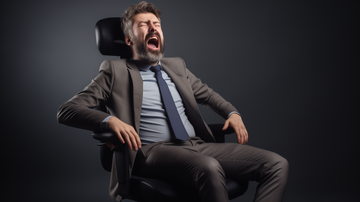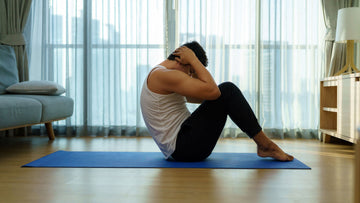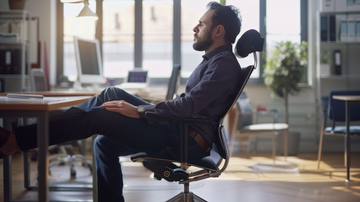Introduction
Back pain is an extremely common issue, with studies estimating that over half of adults will experience low back pain at some point in their lives (https://www.ncbi.nlm.nih.gov/books/NBK538173/). Prolonged sitting has been associated with increased risk of developing chronic back pain. Sitting for long periods can lead to muscle deconditioning, disc compression, and strained ligaments in the spine. Understanding the connection between prolonged sitting and back pain is key to preventing and treating this widespread problem.
Anatomy of the Spine
The human spine is made up of 33 vertebrae stacked on top of each other, providing structure and support for the body. These vertebrae are divided into cervical, thoracic, lumbar, sacral, and coccygeal regions (Mayfield Brain & Spine, Cincinnati). The cervical region contains 7 vertebrae, the thoracic region contains 12, and the lumbar region contains 5 vertebrae.
When viewed from the side, the spine takes on natural S-shaped curves - cervical and lumbar regions curve inward while the thoracic and sacral regions curve outward. These curves help absorb shock and distribute mechanical stress while maintaining proper posture and balance (Cleveland Clinic).
Between each vertebra are intervertebral discs composed of a gelatinous nucleus pulposus surrounded by a fibrous annulus fibrosus. These discs act as shock absorbers, cushioning the vertebrae and providing flexibility to the spine.
Sitting Posture
Sitting with poor posture for extended periods can strain the back muscles and spine. When sitting, many people slouch or hunch over, which compresses the discs between the vertebrae in the lower back. According to research from UCLA Health, "Loss of the lumbar curve from slouching can place extra pressure on the vertebral discs and other structures" (https://www.uclahealth.org/medical-services/spine/patient-resources/ergonomics-prolonged-sitting).
Specifically, slouching rolls the pelvis backward and causes the lower spine to curve abnormally. This stretches the ligaments and strains the facet joints in the vertebrae over time. Additionally, slumping forward with the head jutting forward strains the muscles in the upper back and neck as they work harder to support the weight of the head.
Maintaining proper upright posture is crucial when sitting for long periods to avoid back strain. Sitting with the lower back pressed against the chair back maintains the natural lumbar curve and keeps the head balanced over the torso to minimize muscle strain.
Muscle Deconditioning
Sitting for long periods of time leads to inactivity which causes the muscles in the back and core to weaken over time. According to a 2018 study, prolonged sitting results in minimal leg muscle activity compared to more active positions like standing or walking (https://www.ncbi.nlm.nih.gov/pmc/articles/PMC6122014/).
When the muscles in the back and core become deconditioned due to inactivity, they are unable to properly support the spine. This lack of muscular support puts extra strain on the spinal ligaments and discs as they must compensate to hold the spine in position. Over time, this added strain can lead to back pain and increased risk of injury.
Strong back and core muscles are essential for maintaining proper upright posture while sitting. Weakened muscles allow the pelvis to tilt back and the lower spine to curve abnormally into a slumped position. This places more stress on the spinal structures which can compress the discs and cause pain.
Compression
Sitting applies a compressive force on the spine, pressing the vertebrae and discs together (Back Care Clinic, 2022). This compression reduces the space between the vertebrae, squeezing the intervertebral discs and putting stress on the facet joints that connect the vertebrae (Noregretspt, 2019).
When we sit, the weight of the upper body presses down on the lower back. This constant compression can reduce blood flow to the discs and cause them to lose fluid, making them less flexible and more prone to injury (Coreadvantage, 2022). Over time, the sustained compression from sitting can contribute to disc degeneration and arthritis in the small facet joints.
The lack of movement when sitting also causes the spinal ligaments and muscles to stiffen and shorten. This makes it more difficult to maintain proper posture and increases strain on the back (Coreadvantage, 2022). Regular breaks, stretching, and exercises are necessary to counteract the compression from prolonged sitting.
Stress on Ligaments
Sitting for prolonged periods can put a lot of stress on the ligaments in the spine. Ligaments are tough bands of tissue that connect bones together and provide stability to joints. When sitting in poor posture like slouching or hunching over, the ligaments in the back have to stretch and contort to allow the spine to bend into those positions [1]. Over time, this constant stretching can strain the ligaments and make them more prone to injury. According to one study, sitting in a slouched posture led to significantly more ligament strain compared to sitting upright [2].
If the spinal ligaments become overstretched or damaged, it can lead to joint instability and pain. Weakened ligaments are also more vulnerable to sprains and tears. Some research suggests that prolonged sitting is linked to an increased risk of ligamentous laxity (loose ligaments) in the lumbar spine [2]. This type of instability in the back can cause chronic pain and increase the chances of injury.
Solutions
There are several solutions for reducing back pain from prolonged sitting. The most important is to take frequent breaks to stand up, stretch, and move around. As one expert states, "Frequent breaks once or twice an hour can really help with back pain" (source). This interrupts the static position and allows the spine to decompress. Even standing briefly or walking for just a few minutes per hour can make a big difference.
It's also important to practice good posture when sitting. Sit tall with shoulders back, and avoid slouching or hunching over. Adjust your chair height so your feet are flat on the floor and thighs are parallel to it. Support your lower back with a small pillow or rolled-up towel if needed (source). This takes pressure off the spine.
Finally, strengthening core and back muscles through exercise can improve sitting tolerance and reduce pain. Targeted exercises that improve posture, flexibility, and core stability help counteract the effects of prolonged sitting.
Choosing a Chair
When choosing an office chair for back pain relief, look for adjustable and ergonomic designs that support proper posture. The ideal chair should have adjustable features to accommodate your body size and shape.
Lumbar support is crucial for maintaining the natural curve of your lower spine. Chairs with an adjustable lumbar support allow you to customize the positioning to fit your spine. Proper lumbar support reduces back muscle strain and spinal compression (Source 1).
The seat height should also be adjustable, with your feet resting flat on the floor and thighs parallel to it. This takes pressure off the back of your thighs and promotes proper spinal alignment. Sitting in a chair that is too high or low strains the back muscles and spine (Source 2).
Look for a chair with easily adjustable armrests to support your shoulders and arms. The backrest should support your mid and lower back while allowing you to recline slightly. High-quality ergonomic office chairs designed for back pain often have these key adjustable features.
Exercises and Stretches
There are several simple exercises and stretches you can do from your desk chair to help relieve back tension and strengthen your core:
Seated lower back rotational stretch - Sit on an armless chair or stool. Cross your right leg over your left leg. Bracing your left elbow against the outside of your right knee, twist your upper body to the right as far as is comfortable. Hold for 30 seconds. Switch sides and repeat. This stretches your lower back muscles. (https://www.mayoclinic.org/healthy-lifestyle/adult-health/in-depth/back-pain/art-20546859)
Seated back extension - Sit up tall near the front of your chair with your feet flat on the floor. Place your hands behind your head with elbows out to the side. Gently arch your back and look up towards the ceiling, holding for 2-3 seconds. Slowly return back to the starting position. Repeat 10 times. This strengthens the muscles along your spine. (https://www.orthocarolina.com/media/back-pain-7-stretches-you-can-do-from-your-desk-chair)
Plank - Get on all fours with your hands directly under your shoulders and knees under your hips. Extend your legs straight back one at a time to come into a plank position, engaging your abdominal muscles. Hold for 20-30 seconds before lowering back down. Repeat 2-3 times. This strengthens your entire core.
Conclusion
In summary, sitting for long periods can lead to back pain due to several factors. When we sit, the natural curves of the spine are reduced, putting more stress on the spinal discs, ligaments, and muscles. Sitting also leads to tightness and shortening of the hip flexors and hamstrings. This causes muscle imbalances that pull the pelvis out of alignment and create strain on the lower back. Additionally, the lack of movement when sitting decreases circulation and leads to muscle deconditioning over time. All of these factors combine to increase the risk of back pain.
The key is to avoid prolonged static sitting. It is important to take regular breaks, get up and move around frequently, and maintain good posture when sitting. Stretches that target the hips and core muscles can also help counteract the effects of sitting. Using an ergonomic chair that provides proper support is also beneficial. With some awareness and simple solutions, we can reduce the impact that sitting has on back pain.









